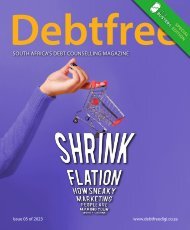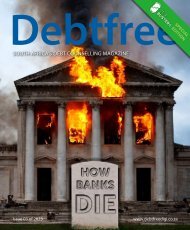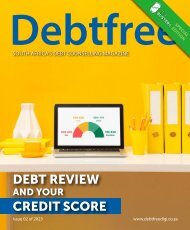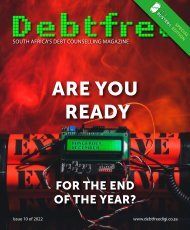May 2022 Debtfree DebtBusters Special Edition
You also want an ePaper? Increase the reach of your titles
YUMPU automatically turns print PDFs into web optimized ePapers that Google loves.
This is manifested in increased demand for debt counselling, with<br />
enquiries up 32% compared to Q1 2021.<br />
These are some of the findings in <strong>DebtBusters</strong>’ latest Debt Index. The<br />
quarterly debt report is compiled from data provided by clients who<br />
have applied for debt counselling.<br />
The analysis found that two years after the start of the coronavirus<br />
pandemic, nominal income has declined marginally. But, when the<br />
effect of cumulative inflation over the past six years is considered, in<br />
real terms South Africans have 31% less disposable income.<br />
It seems that consumers are making up the shortfall in real income by<br />
borrowing.<br />
Unsecured debt levels are 20% higher than in 2016 and for those<br />
taking home more than R20 000 a month unsecured debt has<br />
increased by 54%, which is unsustainably high.<br />
The consequence of this higher debt burden is that consumers need<br />
to spend about 62% of their take-home pay to service their debt.<br />
More alarming is that for the top two income bands debt-to-income<br />
ratios are at their highest levels in the past six years. For those taking<br />
home more than R10 000 per month the ratio is 125% and it is 150%<br />
for those with take-home income of R20 000 or more per month.<br />
Although the average loan size has increased by 27% over the six<br />
years the number of debt obligations has declined by 18%, indicating<br />
that while consumers have more debt per credit agreement, they are<br />
seeking help sooner.

















